
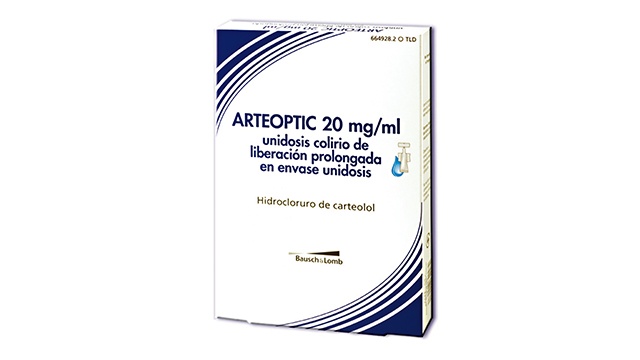
АРТЕОПТИК 20 мг/мл ОДНОДОЗОВІ ОЧНІ КРАПЛІ ПРОЛОНГОВАНОЇ ДІЇ В ОДНОДОЗОВОМУ ПАКУВАННІ

Запитайте лікаря про рецепт на АРТЕОПТИК 20 мг/мл ОДНОДОЗОВІ ОЧНІ КРАПЛІ ПРОЛОНГОВАНОЇ ДІЇ В ОДНОДОЗОВОМУ ПАКУВАННІ

Інструкція із застосування АРТЕОПТИК 20 мг/мл ОДНОДОЗОВІ ОЧНІ КРАПЛІ ПРОЛОНГОВАНОЇ ДІЇ В ОДНОДОЗОВОМУ ПАКУВАННІ
Введення
Опис: інформація для користувача
ARTEOPTIC 20 мг/мл однодозовий колір для тривалого вивільнення в упаковці для одноразового використання
Гідрохлорид картеололу
Прочитайте уважно весь опис перед початком використання цього лікарського засобу, оскільки він містить важливу інформацію для вас.
- Збережіть цей опис, оскільки вам може знадобитися знову його прочитати.
- Якщо у вас виникли питання, проконсультуйтеся з вашим лікарем або фармацевтом.
- Цей лікарський засіб призначений тільки вам, і не слід давати його іншим людям, навіть якщо вони мають такі самі симптоми, оскільки це може їм нашкодити.
- Якщо ви відчуваєте побічні ефекти, проконсультуйтеся з вашим лікарем або фармацевтом, навіть якщо це побічні ефекти, які не вказані в цьому описі. Див. розділ 4.
Зміст опису
- Що таке ARTEOPTIC в упаковці для одноразового використання і для чого він використовується
- Що вам потрібно знати перед початком використання ARTEOPTIC в упаковці для одноразового використання.
- Як використовувати ARTEOPTIC в упаковці для одноразового використання
- Можливі побічні ефекти
- Збереження ARTEOPTIC в упаковці для одноразового використання.
- Зміст упаковки та додаткова інформація
1. Що таке ARTEOPTIC в упаковці для одноразового використання і для чого він використовується
ARTEOPTIC належить до класу лікарських засобів, званих бета-блокаторами.
Він використовується для місцевого лікування наступних очних захворювань:
- Певна форма глаукоми (глаукома хронічного відкритого кута).
- Збільшення тиску в очах (гіпертензія очей).
2. Що вам потрібно знати перед початком використання ARTEOPTIC в упаковці для одноразового використання
Не слід використовувати ARTEOPTIC в упаковці для одноразового використання
- Якщо ви страждаєте на алергію на гідрохлорид картеололу або на будь-який інший компонент цього лікарського засобу (включно з розділом 6).
- Якщо ви страждаєте або страждали в минулому від дихальних захворювань, таких як астма, хронічна обструктивна бронхіт важкого ступеня (важке захворювання легень, яке може спричинити свистіння, труднощі з диханням і/або кашель тривалого часу).
- Якщо ви страждаєте на повільний серцевий ритм, серцеву недостатність або порушення серцевого ритму (нерегулярний серцевий ритм)
- Якщо у вас брадикардія (серцевий ритм менше 45-50 ударів на хвилину).
- Якщо у вас є не лікований феохромоцитом (надмірна вироблення гормонів, яке спричиняє сильне підвищення артеріального тиску).
Попередження та застереження
Проконсультуйтеся з вашим лікарем, фармацевтом або медсестрою перед початком використання ARTEOPTIC. Якщо у вас є або були в минулому:
- Існування коронарного захворювання (симптоми, які можуть включати біль у грудній клітці або слабкість, втома або задуха), серцевої недостатності, зниження артеріального тиску,
- порушення фаз серцевого ритму, такі як брадикардія (повільний серцевий ритм),
- дихальні проблеми, астма або хронічна обструктивна захворювання легень (легеневе захворювання, яке може спричинити свистіння, труднощі з диханням і/або кашель тривалого часу),
- порушення периферичної циркуляції (захворювання Рейно або синдром Рейно),
- цукровий діабет, оскільки картеолол може маскувати ознаки та симптоми низького рівня цукру в крові,
- цукровий діабет може маскувати ознаки та симптоми низького рівня цукру в крові (гіпоглікемія),
- картеолол може маскувати ознаки та симптоми гіперактивності щитоподібної залози,
- лікований феохромоцитом,
- псоріаз,
- корнеальне захворювання,
- історія алергічних реакцій,
- ніркове або печінкове захворювання
Повідомте вашому лікареві, що ви приймаєте ARTEOPTIC, перед тим як піддатися анестезії, оскільки картеолол може змінити ефекти деяких лікарських засобів під час анестезії.
Для контролю того, щоб ви не розвивали резистентність до терапевтичної ефективності цього продукту, коли ви приймаєте цей лікарський засіб, ви повинні бути піддані періодичним офтальмологічним оглядах на початку лікування та пізніше, приблизно кожні 4 тижні. Крім того, у разі тривалого лікування огляди повинні контролювати, чи відбувається порушення лікування (втрата ефективності лікарського засобу).
Якщо ви використовуєте контактні лінзи: інгібіція виробництва сліз, можливо, пов'язана з цією групою лікарських засобів, може спричинити ризик непереносимості в користувачів контактних лінз.
Якщо ви страждаєте на важке пошкодження рогівки (прозорої оболонки передньої частини ока), лікування фосфатами, в рідких випадках, може спричинити розмитість зору через накопичення кальцію.
Активний інгредієнт цього лікарського засобу може спричинити позитивний результат у тестах на допінг.
Діти та підлітки
Цей колір не слід використовувати у недоношених дітей або новонароджених, ні у дітей чи підлітків.
Використання ARTEOPTIC в упаковці для одноразового використання з іншими лікарськими засобами
ARTEOPTIC може впливати або бути під впливом інших лікарських засобів, коли вони використовуються, включаючи інші коліри для лікування глаукоми.
- Якщо ви використовуєте інші лікарські засоби для застосування в очах, ви повинні:
- застосувати інший лікарський засіб для очей
- почекати 15 хвилин
- застосувати ARTEOPTIC останнім
- Ваш лікар також може призначити вам міотичний колір для лікування певного типу глаукоми (наприклад, глаукоми закритого кута).
- Потрібен офтальмологічний контроль, якщо ви використовуєте колір адреналіну/епінефрину одночасно з ARTEOPTIC (через ризик розширення зіниці).
- Якщо ви приймаєте бета-блокатори перорально одночасно, часто потрібно коригувати дозу ARTEOPTIC.
Хоча кількість бета-блокатора, який потрапляє в кров після застосування в очах, низька, вам потрібно враховувати взаємодії, які спостерігаються з пероральними бета-блокаторами:
- Не рекомендується використання аміодарону (яка використовується для лікування порушень серцевого ритму), деяких антагоністів кальцію (які використовуються для лікування гіпертонії, таких як дилтіазем, фінголімод, озанімод і верапаміл) або інших бета-блокаторів (які використовуються для лікування серцевої недостатності).
- Всі бета-блокатори можуть маскувати певні симптоми гіпоглікемії: серцебиття і тахікардія.
- Можливо підвищення рівня лідокаїну (яка вводиться внутрішньовенно) в крові, що підвищує ризик побічних ефектів на серце і нервову систему.
Коли використовується більше одного лікарського засобу для місцевого застосування в очах, адміністрації лікарських засобів повинні бути розставлені з інтервалом не менше 15 хвилин. Очні мазі повинні застосовуватися в останню чергу.
Повідомте вашому лікареві, якщо ви використовуєте або плануєте використовувати лікарські засоби для зниження артеріального тиску, лікарські засоби для серця, лікарські засоби для лікування цукрового діабету або множинного склерозу.
Повідомте вашому лікареві або фармацевту, якщо ви використовуєте або нещодавно використовували інші лікарські засоби, включаючи ті, які придбані без рецепта. Вони проведуть спеціальний контроль, якщо це буде потрібно.
Вагітність і лактація
Якщо ви вагітні або перебуваєте в період лактації, вважаєте, що можете бути вагітні або плануєте завагітніти, проконсультуйтеся з вашим лікарем або фармацевтом перед тим, як використовувати цей лікарський засіб.
Вагітність
Не використовуйте ARTEOPTIC, якщо ви вагітні, якщо тільки ваш лікар не вважає, що це необхідно.
Немає достатніх даних про використання гідрохлориду картеололу у вагітних жінок.
Для зниження системної абсорбції див. розділ 3.
Лактація
Не використовуйте ARTEOPTIC, якщо ви годуєте грудьми. Гідрохлорид картеололу може потрапляти в грудне молоко.
Бета-блокатори виділяються з грудним молоком. Однак при терапевтичних дозах коліру гідрохлориду картеололу малоймовірно, що буде достатньо велика кількість в грудному молоці, щоб спричинити клінічні симптоми бета-блокади у дітей. Для зниження системної абсорбції див. розділ 3.
Проконсультуйтеся з вашим лікарем перед тим, як приймати будь-який лікарський засіб під час лактації.
Водіння автомобіля і використання машин
Після застосування цього продукту в очах може виникнути розмитість зору.
Не водьте автомобіль і не використовуйте машини, поки не відновите нормальне зір.
ARTEOPTIC в упаковці для одноразового використання містить фосфатний буфер
Цей лікарський засіб містить 0,049 мг фосфатів у кожній краплі, що відповідає 1,4 мг/мл.
3. Як використовувати ARTEOPTIC в упаковці для одноразового використання
Цей лікарський засіб повинен бути введений в очі (офтальмологічний шлях).
Слідуйте точно інструкціям щодо застосування цього лікарського засобу, вказаним вашим лікарем. У разі сумнівів проконсультуйтеся з вашим лікарем або фармацевтом.
ARTEOPTIC містить спеціальний допоміжний інгредієнт, який має певні фізичні властивості, що дозволяють застосовувати його один раз на добу.
Рекомендована доза - одна крапля в око або обидва очі, один раз на добу, вранці.
Однак ваш лікар може вирішити коригувати дозу, особливо якщо ви приймаєте бета-блокатори перорально одночасно (див. розділ 2 «Використання інших лікарських засобів»).
Інструкції з застосування
- Якщо ви носите контактні лінзи, ви повинні їх видалити перед застосуванням ARTEOPTIC і чекати 15 хвилин перед тим, як знову їх надіти.
- Для правильного застосування ARTEOPTIC:
- Ви повинні помити руки перед застосуванням крапель.
- Перед кожним новим застосуванням відокреміть одну упаковку для одноразового використання від стрічки.
- Поверніть край флакона, щоб відкрити упаковку для одноразового використання. Помістіть упаковку для одноразового використання донизу, легонько стукніть по корпусу флакона, щоб розвести розвинути розчин до отвору.
- Уникайте дотику ока або повіки краєм упаковки.
- Для лікування потягніть нижню повіку вниз і впроваджайте одну краплю, дивлячись вгору.
- Після застосування закрийте око на кілька секунд.
- З око закритим, видаліть будь-яку надмірну кількість лікарського засобу.
- Після застосування ARTEOPTIC натисніть пальцем на кут ока біля носа протягом 2 хвилин. Це запобігає потраплянню активної речовини (картеололу) в решту організму.
- З око закритим, видаліть будь-яку надмірну кількість лікарського засобу.
- Видаліть упаковку для одноразового використання негайно після використання.
- Не використовуйте вміст упаковок для одноразового використання, які вже були відкриті або розпочаті.
- Кількість крапель в упаковці достатня для лікування обидвох очей.
Відокремте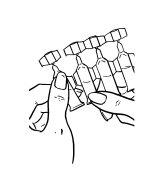 Поверніть кришку, щоб відкрити її
Поверніть кришку, щоб відкрити її
Переверніть упаковку повністю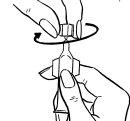 Впроваджайте в око
Впроваджайте в око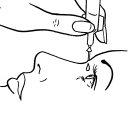
Видаліть після використання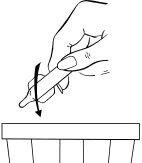
- Якщо ви використовуєте інший лікарський засіб, який застосовується в очах, ви повинні:
- Застосувати інший лікарський засіб для очей спочатку
- Чекати 15 хвилин
- Останнім застосовувати ARTEOPTIC
- Якщо ваш лікар призначив вам ARTEOPTIC замість іншого лікарського засобу, ви повинні припинити використання іншого коліру в кінці повного дня лікування.
- Почніть лікування ARTEOPTIC на наступний день, у дозі, яку призначив ваш лікар.
- Якщо ви вважаєте, що дія ARTEOPTIC надто сильна або слабка, повідомте вашому лікареві або фармацевту.
Не ін'єкціюйте і не ковтайте.
Тривалість лікування
Слідуйте інструкціям вашого лікаря. Він скаже вам, як довго вам потрібно використовувати ARTEOPTIC. Не переривайте лікування раніше.
Якщо ви використовуєте більше ARTEOPTIC в упаковці для одноразового використання, ніж потрібно:
Якщо ви ввели надто багато крапель в очі, промийте їх чистою водою.
У разі випадкового перорального прийняття вмісту упаковки можуть виникнути певні побічні ефекти, такі як відчуття пустоти в голові, труднощі з диханням або відчуття, що ваш пульс сповільнився.
У разі передозування або випадкового прийняття проконсультуйтеся з вашим лікарем або фармацевтом або зверніться до служби токсикологічної інформації за телефоном (91) 562 04 20.
Якщо ви забули використовувати ARTEOPTIC в упаковці для одноразового використання
Не використовуйте подвійну дозу, щоб компенсувати забуту дозу.
Якщо ви припиняєте лікування ARTEOPTIC в упаковці для одноразового використання
Якщо ви припиняєте лікування, це може підвищити внутрішньоочний тиск в ваших очах і спричинити розмитість зору.
Ніколи не припиняйте лікування без консультації з вашим лікарем або фармацевтом.
Якщо у вас є інші питання щодо використання цього лікарського засобу, проконсультуйтеся з вашим лікарем або фармацевтом.
4. Можливі побічні ефекти
Як і всі лікарські засоби, цей лікарський засіб може спричиняти побічні ефекти, хоча не всі люди їх відчувають.
Зазвичай ви можете продовжувати застосовувати колір, якщо тільки побічні ефекти не будуть важкими. Якщо ви стурбовані, проконсультуйтеся з вашим лікарем або фармацевтом. Не припиняйте використання ARTEOPTIC без повідомлення вашому лікареві.
Як і інші лікарські засоби, що застосовуються в очах (офтальмологічні лікарські засоби, що застосовуються місцево), ARTEOPTIC може бути абсорбований і потрапляти в кров. Це може спричиняти побічні ефекти, які спостерігаються при системному застосуванні бета-блокаторів. Частота побічних ефектів після місцевого застосування в очах нижча, ніж при пероральному або ін'єкційному застосуванні інших лікарських засобів. Побічні ефекти, перелічені нижче, включають побічні реакції, спостережені при інших бета-блокаторах для очей:
Частота наступних побічних ефектів є частою (може впливати до 1 особи з 10)
- Ознаки та симптоми очної іритації (наприклад, печіння), біль в оці (наприклад, свербіж), відчуття печіння, набряк, сльозотеча, червоні очі, червоність кон'юнктиви, кон'юнктивіт, іритація або відчуття чужорідного тіла в оці (кератит).
- Порушення смаку.
Частота наступних побічних ефектів є рідкою (може впливати до 1 особи з 100)
- Головокружіння
- Слабкість м'язів або біль, не викликаний фізичними вправами (міалгія), м'язові спазми.
Частота наступних побічних ефектів є дуже рідкою (може впливати до 1 особи з 1000)
- Позитивні результати антиядерних антитіл.
У дуже рідких випадках деякі пацієнти з важкими пошкодженнями рогівки (прозорої оболонки передньої частини ока) розвивали корнеальну опалізацію через відкладення кальцію під час лікування.
Частота наступних побічних ефектів є невідомою (частота не може бути оцінена на основі наявних даних
- Алергічні реакції, включаючи раптове набрякання обличчя, губ, рота, язика або горла, яке може спричиняти проблеми з диханням або ковтанням, висип, локалізований і загальний, свербіж, алергічна реакція, яка загрожує життям.
- Низький рівень цукру в крові
- Труднощі з сном (безсоння), депресія, кошмари, зниження лібідо.
- Омана, інфаркт, зниження кровотоку в деяких частинах мозку, збільшення ознак і симптомів міастенії (м'язової хвороби), оніміння або поколювання рук і ніг, поколювання, головний біль, втрата пам'яті.
- Набряк повік (блефарит), розмитість зору, зниження чутливості рогівки після операції на оці (відшарування рогівки після операції з фільтрацією), зниження чутливості рогівки, сухі очі, пошкодження передньої частини ока (ерозія рогівки), опущення верхньої або нижньої повіки, подвійне бачення, зміни рефракції (іноді через припинення лікування краплями для очей).
- Повільний серцевий ритм, серцебиття, зміни в ритмі або швидкості серцебиття, захворювання серця з труднощами з диханням і набряком ніг і ступнів через накопичення рідини (серцевої недостатності), стан серця (блокада атріовентрикулярної).
- Низький артеріальний тиск, феномен Рейно, холодні руки і ноги, м'язові спазми і/або біль в ногах при ходьбі (інтермітентна клAUDикація).
- Бронхоспазм (труднощі з диханням або свистіння - переважно у пацієнтів з попередньо існуючою бронхоспастичною хворобою), коротке дихання (диспное), кашель.
- Нудота, диспепсія, діарея, сухість у роті, біль у животі, блювота.
- Випадіння волосся, висип на шкірі з сріблясто-білим кольором (псоріформний висип) або загострення псоріазу, шкірні висипи.
- Системний червоний вовчак.
- Сексуальна дисфункція, імпотенція.
- Незвичайна м'язова слабкість або біль, не викликаний фізичними вправами (астенія) або втома, біль у грудній клітці, накопичення рідини (едем).
Повідомлення про побічні ефекти:
Якщо ви відчуваєте будь-який побічний ефект, проконсультуйтеся з вашим лікарем, фармацевтом або медсестрою, навіть якщо це побічні ефекти, які не вказані в цьому описі. Ви також можете повідомити про них безпосередньо через систему фармакологічного нагляду за лікарськими засобами для людини: https://www.noficaram.es. Повідомляючи про побічні ефекти, ви можете допомогти надати більше інформації про безпеку цього лікарського засобу.
5. Збереження ARTEOPTIC в упаковці для одноразового використання
- Тримайте цей лікарський засіб поза зоною досяжності дітей.
- Не використовуйте цей лікарський засіб після закінчення терміну придатності, вказаного на упаковці після "EXP" (абревіатура англійською мови для терміну придатності). Термін придатності - останній день місяця, який вказано.
- Не зберігайте при температурі вище 25°C.
- Він повинен бути видалений після 28 днів після першого відкриття флакона.
- Не використовуйте, якщо кришка пошкоджена.
Лікарські засоби не повинні викидатися в каналізацію або сміття. Відкладайте упаковки та лікарські засоби, які вам не потрібні, в пункті збору SIGRE аптеки. У разі сумнівів проконсультуйтеся з вашим фармацевтом, як позбутися упаковок та лікарських засобів, які вам не потрібні. Таким чином, ви допоможете захистити навколишнє середовище.
6. Зміст упаковки та додаткова інформація
Склад Артеоптика 2% офтальмологічних крапель із затриманою дією в упаковці для одноразового використання
- Активна речовина:гідрохлорид картеололу.
Артеоптик 20 мг/мл: кожний мл офтальмологічних крапель містить 20 мг гідрохлориду картеололу або кожна упаковка для одноразового використання (0,2 мл) містить 4 мг гідрохлориду картеололу.
- Інші компоненти:дигідрогенфосфат натрію дигідрат, фосфат динатрію додекагідрат, хлорид натрію, альгінова кислота, гідроксид натрію (для регулювання pH) та очищена вода.
Вигляд продукту та вміст упаковки
Цей лікарський засіб є бета-блокатором для офтальмологічного застосування.
Артеоптик 20 мг/мл офтальмологічні краплі із затриманою дією випускаються у вигляді прозорої та легенько жовто-коричневої рідини в упаковці для одноразового використання об'ємом 0,2 мл та упаковуються в конверт (поліестер/алюміній/поліетилен).
Упаковка містить 30 упаковок для одноразового використання.
Можливо, що будуть реалізовані лише деякі розміри упаковок.
Власник дозволу на маркетинг та відповідальна особа за виробництво
Власник дозволу на маркетинг:
BAUSCH + LOMB IRELAND LIMITED
3013 Lake Drive
Citywest Business Campus
Dublin 24, D24PPT3
Ірландія
Відповідальна особа за виробництво:
Laboratoire CHAUVIN
Zone Industrielle Ripotier Haut - 07200 Aubenas
Франція
Місцевий представник:
Bausch&Lomb S.A.
Avda. Valdelaparra nº4
28108 Alcobendas (Мадрид)
Цей лікарський засіб дозволений в країнах-членах Європейського економічного простору під наступними назвами:
Франція: Carteol L.P 1% та Carteol L.P 2% колір для офтальмологічного застосування із затриманою дією в упаковці для одноразового використання.
Португалія: Physioglau 1% та Physioglau 2% офтальмологічні краплі із затриманою дією, упаковка для одноразового використання.
Італія: Fortinol 1% та 2% монодоза, офтальмологічні краплі із затриманою дією, упаковка для одноразового використання.
Іспанія: Артеоптик 20 мг/мл, офтальмологічні краплі із затриманою дією, упаковка для одноразового використання.
Дата останнього перегляду цього посібника:Лютий 2023
Детальна та актуальна інформація про цей лікарський засіб доступна на сайті Іспанського агентства з лікарських засобів та медичних продуктів (AEMPS) http://www.aemps.gob.es/

Скільки коштує АРТЕОПТИК 20 мг/мл ОДНОДОЗОВІ ОЧНІ КРАПЛІ ПРОЛОНГОВАНОЇ ДІЇ В ОДНОДОЗОВОМУ ПАКУВАННІ в Іспанії у 2025 році?
АРТЕОПТИК 20 мг/мл ОДНОДОЗОВІ ОЧНІ КРАПЛІ ПРОЛОНГОВАНОЇ ДІЇ В ОДНОДОЗОВОМУ ПАКУВАННІ коштує в середньому 3.81 євро у листопад, 2025 році. Ціна може змінюватися залежно від регіону, аптеки та наявності рецепта. Рекомендуємо перевіряти актуальну вартість у місцевих аптеках або через онлайн-сервіси.
- Країна реєстрації
- Середня ціна в аптеках3.81 EUR
- Доступність у аптекахПроблеми з постачанням
- Діючі речовини
- Потрібен рецептТак
- Виробник
- Інформація є довідковою і не є медичною порадою. Перед прийомом будь-яких препаратів обов'язково проконсультуйтеся з лікарем. Oladoctor не несе відповідальності за медичні рішення, прийняті на основі цього контенту.
- Альтернативи до АРТЕОПТИК 20 мг/мл ОДНОДОЗОВІ ОЧНІ КРАПЛІ ПРОЛОНГОВАНОЇ ДІЇ В ОДНОДОЗОВОМУ ПАКУВАННІФорма випуску: ОЧНІ КРАПЛІ ПРОЛОНГОВАНОЇ ДІЇ, 10 мг картеололу гідрохлориду/млДіючі речовини: carteololВиробник: Bausch + Lomb Ireland LimitedПотрібен рецептФорма випуску: ОЧНІ КРАПЛІ ПРОЛОНГОВАНОЇ ДІЇ, 20 МГ/МЛДіючі речовини: carteololВиробник: Bausch + Lomb Ireland LimitedПотрібен рецептФорма випуску: NULL, 20 мг/млДіючі речовини: carteololВиробник: Bausch + Lomb Ireland LimitedПотрібен рецепт
Аналоги АРТЕОПТИК 20 мг/мл ОДНОДОЗОВІ ОЧНІ КРАПЛІ ПРОЛОНГОВАНОЇ ДІЇ В ОДНОДОЗОВОМУ ПАКУВАННІ в інших країнах
Найкращі аналоги з тією самою діючою речовиною та терапевтичним ефектом.
Аналог АРТЕОПТИК 20 мг/мл ОДНОДОЗОВІ ОЧНІ КРАПЛІ ПРОЛОНГОВАНОЇ ДІЇ В ОДНОДОЗОВОМУ ПАКУВАННІ у Польща
Лікарі онлайн щодо АРТЕОПТИК 20 мг/мл ОДНОДОЗОВІ ОЧНІ КРАПЛІ ПРОЛОНГОВАНОЇ ДІЇ В ОДНОДОЗОВОМУ ПАКУВАННІ
Консультація щодо дозування, побічних ефектів, взаємодій, протипоказань та поновлення рецепта на АРТЕОПТИК 20 мг/мл ОДНОДОЗОВІ ОЧНІ КРАПЛІ ПРОЛОНГОВАНОЇ ДІЇ В ОДНОДОЗОВОМУ ПАКУВАННІ – за рішенням лікаря та згідно з місцевими правилами.














